What they saw was a collection of seemingly unconnected images, ridiculous dialogue, and nudity. The audience howled, screamed, threw things at the screen and finally walked out, preferring the police tear gas and the protests outside to Le viol du vampire. Since there were only two films opening in Paris that week, all the newspapers sent reviewers. They hated it and Rollin became known as the man who made the most incomprehensible film ever. It would be years before anyone looked at Rollin’s movies with anything close to an open mind.
Revolution was in the air and on film in the 1960s and 1970s all around the world. Censorship had broken down in Europe ten years before it would in the United States and United Kingdom, and the horror film began evolving into a combination of terror and eroticism that became the formula that produced some surreal and perverse films. And low budget film makers like Rollin were all over it. Meanwhile, overseas censors left some of the best frames on the cutting room floor to satisfy American Puritanism and English snobbery.
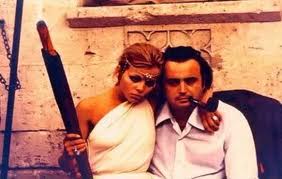
Rollin was an artist and writer whose heroes were the surrealist film makers Luis Buñuel and Georges Franju. Like Franju, Rollin was long on the visuals and short on the narrative. He has said he wasn’t a horror director but that the horror genre simply allowed him the freedom to do things that would not be acceptable in a more conventional film. Consequently, he made films built around images rather than a logical story. The story acts to link the images and since Rollin’s images are a bit weird, the story, or what there is, becomes so too. In a bizarre way, it gives some kind of sense to the whole thing.
Imagery and fantasy so dominated Rollin’s thoughts and work that nothing else really mattered. As a result his films were often considered unacceptable to horror fans: his vampires were humanistic, there was a lack of focus on the supernatural, and the suspense was not heightened enough. In many ways, horror fans are close minded; unlike most genre fans who accept whatever the movie industry gives them, horror fans have fixed and rigid ideas on what makes a horror film. They know what goes bump in the night and they don’t like anyone messing with the conventions that have made horror films so predictable. They wanted something more faithful to the Stoker legend. They wanted a Hammer film.
But what they got is what Rollin called “mad love stories” set in remote chateaus, lonely beaches, institutions, and cemeteries. And the images were striking: a grand piano being played in the middle of a cemetery, a pale-skinned woman tied naked to the ruins of a pier on a grey beach, a striking blonde in a white gown with a black Great Dane, a beautiful woman dressed only in a black cape stalking her prey with a two-handed scythe, and, most famously, a vampire emerging from a grandfather clock. (Of this Rollin said, “A grandfather clock is of no interest. A vampire woman getting out of this clock at midnight, that’s me!”). His films reside somewhere between fairy tale and fantasy, waking and dreaming. His films even reportedly put some in the audience to sleep.
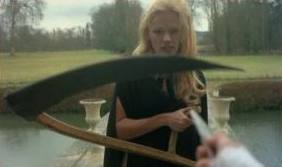
Imagery and fantasy so dominated Rollin’s thoughts and work that nothing else really mattered. As a result his films were often considered unacceptable to horror fans: his vampires were humanistic, there was a lack of focus on the supernatural, and the suspense was not heightened enough. In many ways, horror fans are close minded; unlike most genre fans who accept whatever the movie industry gives them, horror fans have fixed and rigid ideas on what makes a horror film. They know what goes bump in the night and they don’t like anyone messing with the conventions that have made horror films so predictable. They wanted something more faithful to the Stoker legend. They wanted a Hammer film.
But what they got is what Rollin called “mad love stories” set in remote chateaus, lonely beaches, institutions, and cemeteries. And the images were striking: a grand piano being played in the middle of a cemetery, a pale-skinned woman tied naked to the ruins of a pier on a grey beach, a striking blonde in a white gown with a black Great Dane, a beautiful woman dressed only in a black cape stalking her prey with a two-handed scythe, and, most famously, a vampire emerging from a grandfather clock. (Of this Rollin said, “A grandfather clock is of no interest. A vampire woman getting out of this clock at midnight, that’s me!”). His films reside somewhere between fairy tale and fantasy, waking and dreaming. His films even reportedly put some in the audience to sleep.

If style over story was the main attraction to Rollin’s films, it was not the only one. Sex and nudity are prevalent in Rollin’s films. Admittedly, this was done to lure patrons to the theater which in turn helped him raise money for his projects. Young actresses were warned not to work with Rollin and some stayed away. Many of Rollin’s female stars were first timers and the acting did come off as amateurish. But sometimes there is nothing wrong with actors delivering lines without the theatrical flair of a pro. If Rollin needed a pro, he would hire porn actresses who were more comfortable doing nude scenes.
Rollin seemed to prefer (to say the least) girls as the central characters in his films. Lesbian vampires were the main attraction in the Euro-horror films of the 1970s and for good reason. I mean when you think about it, you almost can’t screw that up. For his part, Rollin simply preferred to show two naked girls rather than a girl and a man. An artist at heart, Rollin once said, a “naked girl is always poetry.” In his cinema, sensuality and poetry becomes surrealism when a naked girl comes out of a grandfather clock and the clock is no longer just a clock.
Rollin was not immune to the criticism of his work. When he tried something different – such as the very good The Iron Rose – critics panned it. Rollin was devastated. All his own money was invested in the film. Rollin was always struggling to find money for his films and as a result was usually faced with shooting schedules of two weeks and a budget that wouldn’t add up to the money spent on pizza and Red Bull in a James Cameron production.

Rollin seemed to prefer (to say the least) girls as the central characters in his films. Lesbian vampires were the main attraction in the Euro-horror films of the 1970s and for good reason. I mean when you think about it, you almost can’t screw that up. For his part, Rollin simply preferred to show two naked girls rather than a girl and a man. An artist at heart, Rollin once said, a “naked girl is always poetry.” In his cinema, sensuality and poetry becomes surrealism when a naked girl comes out of a grandfather clock and the clock is no longer just a clock.
Rollin was not immune to the criticism of his work. When he tried something different – such as the very good The Iron Rose – critics panned it. Rollin was devastated. All his own money was invested in the film. Rollin was always struggling to find money for his films and as a result was usually faced with shooting schedules of two weeks and a budget that wouldn’t add up to the money spent on pizza and Red Bull in a James Cameron production.

The lack of money and time meant there were no rehearsals. Rollin had to teach his actors their lines while they were setting up the scene. All his films were shot on location which meant problems getting permission to do so and dodging bad weather. The shoots had to be done fast and usually with one take. And while he was shooting he was editing in his head because there would be little time for that after filming was done.
Rollin made forty-seven feature length films from 1968 to 2010. While his films do require a bit more audience participation than most in the horror genre, if you can make it through the slow action, long takes and periods of silence, there is a rewarding cinematic experience. Admittedly some of his stuff is a complete mess and for years critics have talked about how bad he was. Now, after his death, his work is being reevaluated. Film critic Tim Lucas, writing for Video Watchdog, has said Rollin possessed “one of the purest imaginations ever consecrated to the horror genre.”
Redemption Films and Kino have teamed up to release Redemption’s Jean Rollin catalog on Blu-ray. Here are the films from that catalog worth checking out. Listed in chronological order….
____________________________________________________________
Le viol du Vampire (The Rape of the Vampire, 1968)
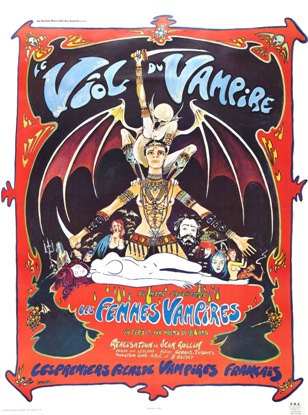
Rollin made forty-seven feature length films from 1968 to 2010. While his films do require a bit more audience participation than most in the horror genre, if you can make it through the slow action, long takes and periods of silence, there is a rewarding cinematic experience. Admittedly some of his stuff is a complete mess and for years critics have talked about how bad he was. Now, after his death, his work is being reevaluated. Film critic Tim Lucas, writing for Video Watchdog, has said Rollin possessed “one of the purest imaginations ever consecrated to the horror genre.”
Redemption Films and Kino have teamed up to release Redemption’s Jean Rollin catalog on Blu-ray. Here are the films from that catalog worth checking out. Listed in chronological order….
____________________________________________________________
Le viol du Vampire (The Rape of the Vampire, 1968)

Rollins’ first film was shot as two shorts then edited together. The entire cast was killed off at the end of Part 1 only to reappear in Part 2. The result is a disastrous film but it is ultimately considered an important film in Rollin’s oeuvre. A few of Rollin’s themes, which he would return to many times, were introduced here: lesbian vampires and vampires hanging out in cemeteries and desolate beaches on the Normandy coast. As always with Rollin, imagery is the main thing and we see a vampire emerging from out of the sea, a vampire marriage that was actually filmed in the old Grand Guignol Theater, lots of blood, and lovers being sealed in a coffin. The film was shot in black and white.
La vampire nue (The Nude Vampire, 1970)
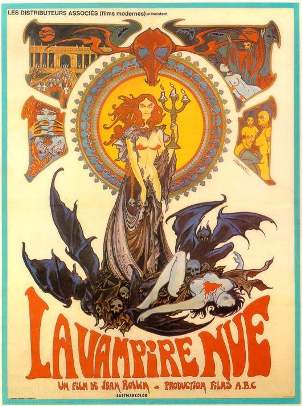

A bizarre suicide cult is the backdrop for this film about a group of humans who want to find a vampire to mate with the female vampire that they have. This one opens with a woman fleeing from the cult’s private snuff club, pursued by three people wearing animal headgear and masks. We also see women wearing six-inch spiked pasties, bizarre dolls, and twins! The vampires are the good guys who want to save their captive sister. And in a scene right out of Frankenstein, they attack the chateau carrying torches. The excellent soundtrack is avant-garde, Sun Ra-esque jazz that is as incongruous as the rest of the film.
Le frisson des vampires (The Shiver of the Vampires, 1971)
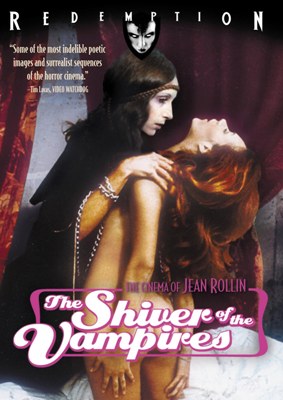

Rollin was still struggling with adapting his experimental ideas of film making into something that could be commercially successful and with this movie he accomplishes that to some degree. The English language dubbing is unfortunate and the English accents given to some vampires come off as ridiculous. Some things just don’t translate – especially when written by Rollin. But, as always, the visuals are top notch. This one features dialogue that was made up by the actors as they filmed, a story that never quite meshes with the images, and a bizarre progressive rock soundtrack by a group of unheard of (before and after) musicians. Oh yeah, and there’s also Domique, the skinny, pale vampire who emerges from grandfather clocks and chimneys.
Requiem for a Vampire (1973)
 Two girls are on the run after escaping from a reform school. They end up in a castle inhabited by the last of the vampires. He’s getting old and tired and seeks virgin blood to extend his life. Of course our two runaways are virgins and one of them is ready for the sacrifice. “We got lost,” says one, “eternally lost.” This film further defines the Rollin film language: two female runaways, lonely people, castles, bizarrely dressed characters, humanistic vampires, and doomed love affairs. There are unnecessarily long takes of naked young women chained to the walls being raped and tortured by the vampire’s human entourage. You will also see a bat perform, er, batilingus on one of the unfortunate detainees.
Two girls are on the run after escaping from a reform school. They end up in a castle inhabited by the last of the vampires. He’s getting old and tired and seeks virgin blood to extend his life. Of course our two runaways are virgins and one of them is ready for the sacrifice. “We got lost,” says one, “eternally lost.” This film further defines the Rollin film language: two female runaways, lonely people, castles, bizarrely dressed characters, humanistic vampires, and doomed love affairs. There are unnecessarily long takes of naked young women chained to the walls being raped and tortured by the vampire’s human entourage. You will also see a bat perform, er, batilingus on one of the unfortunate detainees.
 Two girls are on the run after escaping from a reform school. They end up in a castle inhabited by the last of the vampires. He’s getting old and tired and seeks virgin blood to extend his life. Of course our two runaways are virgins and one of them is ready for the sacrifice. “We got lost,” says one, “eternally lost.” This film further defines the Rollin film language: two female runaways, lonely people, castles, bizarrely dressed characters, humanistic vampires, and doomed love affairs. There are unnecessarily long takes of naked young women chained to the walls being raped and tortured by the vampire’s human entourage. You will also see a bat perform, er, batilingus on one of the unfortunate detainees.
Two girls are on the run after escaping from a reform school. They end up in a castle inhabited by the last of the vampires. He’s getting old and tired and seeks virgin blood to extend his life. Of course our two runaways are virgins and one of them is ready for the sacrifice. “We got lost,” says one, “eternally lost.” This film further defines the Rollin film language: two female runaways, lonely people, castles, bizarrely dressed characters, humanistic vampires, and doomed love affairs. There are unnecessarily long takes of naked young women chained to the walls being raped and tortured by the vampire’s human entourage. You will also see a bat perform, er, batilingus on one of the unfortunate detainees.
La rose de fer (The Iron Rose, 1973)
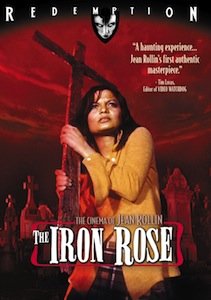

Rollin once got lost in a cemetery with a friend and before they finally found their way out the director had the idea for this story. A young couple gets lost and is locked in a cemetery, forced to stay there for the night. Sometimes the things that aren’t there are the scariest and this cemetery is so bizarre that we don’t need any actual creatures of the night. The setting is pure Rollin: stone crosses, tombstones, statues, iron fences and gates, and overgrown vegetation. Sometimes a graveyard is just a graveyard but the girl becomes possessed by the spirits/souls of the grave and goes slowly insane, dragging her accomplice into the abyss. There are long takes and quick shots, exceptional camera direction and shot composition. This film is not just beautiful to look at, but is also a very good movie.
Les raisins de la mort (The Grapes of Death, 1978)
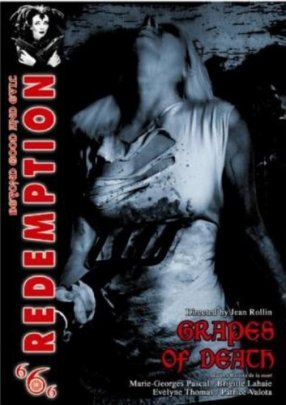

In addition to being one of the all-time great titles, this is considered the first French zombie movie. But it’s a Rollin film so the zombies really aren’t zombies as we know them. In the country vineyards of France they are spraying the grapes with a chemical that has a decidedly negative effect on humans. But unlike most zombies, these ghouls are aware of what they are and still have a conscience. In a very good scene a zombie impales his girlfriend on a pitchfork and cuts her head off while telling her that he loves her. Then, like a cat proud of the mouse he has caught, he carries her head around with him. This film departs from the claustrophobic style of George Romero who preferred his zombies attacking humans who are holed up in a small house. Rollin’s countryside setting is novel enough to make it almost unrecognizable as a zombie flick, but this is still a solid gore flick.
Fascination (1979)
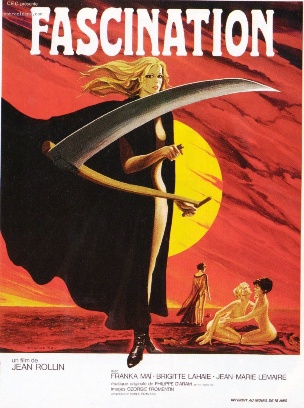

Some say Rollin’s best, this film features his most important actress, Brigitte Lahaie. A country chateau surrounded by a moat is home to a female blood-cult. An unlucky wanderer picks the wrong door to knock on. The two beautiful women who are home seduce him then warn him to get out before nightfall when the rest of the blood drinkers arrive – too late. The photography and imagery are striking: a group of upper class women drinking blood out of crystal glasses in a slaughter house, the statuesque Lahaie in black cape with scythe, and a chateau surrounded by a moat.
La nuit des traquées (The Night of the Hunted, 1980)
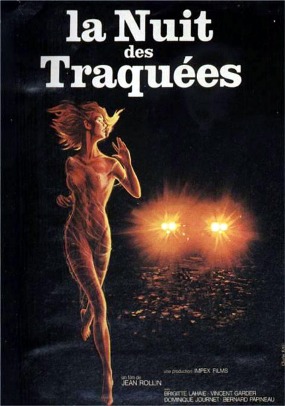

Romantic tragedy and lost memory in a cold black high rise in Paris. Medical experiments gone awry have resulted in people who have lost the ability to retain memories. Two young women escape from the institution run by evil doctors but are captured and returned. All of the patients are zombie-like creatures who can’t remember who they are. In an almost pathetic scene, our two lost girls make up memories so they can hang on to reality. Shot in two weeks with no budget, it even looks cheap. Rollin got permission to film in a Paris office tower at night after everyone had gone home. La nuit des traquées got the worst notices of Rollin’s career. It’s not his worst film though, not by a long shot. Of course it has a tragic and sad ending in which, once again, Rollin gives us his favorite final scene: doomed lovers walking off into oblivion.
La morte vivante (The Living Dead Girl, 1982)


Rollin’s recurring theme of two young women in a tragic fairy tale takes place in a country chateau outside of Paris. The recently deceased Catherine has had her casket opened by some grave robbers who have also contaminated the catacombs in which she resides with toxic waste. The combination of these two events somehow wakes up our living dead girl. And of course she needs blood to survive. Her childhood friend, Helene brings her victims so she can stay “alive.” All this leads to yet another sad, beautifully done ending. Rollin had the time to rehearse his actors and it shows. He got permission to film in the chateau and the whole crew stayed there while filming, which helped with the money. One of Rollin’s best films was also one of his most commercially successful.
Les deux orphelines vampires (Two Orphan Vampires, 1997)


The opening credits are shown over a beautiful cemetery scene shot with perfect lighting, camera movement and color. The story seems strangely put together as if the editing was done to hide something. But it doesn’t matter as this is an absolutely beautiful film to look at with the striking scenes and images you would expect from Rollin. Our two orphans are blind by day but regain their sight after the sun goes down. Each night they leave the nuns at the orphanage behind and set out on their strange journeys. Along the way they meet other creatures of the night and the two girls always politely introduce themselves with a heavily vampire accented, “We are the two orphan vampires.” Again, Rollin’s humanistic vampires have no extraordinary strength or powers, but they do love their blood and the cemetery is where they feel at home. The dialogue between our two vampires is poetic as is the sad ending. This is one of Rollin’s best.
Dracula’s Fiancee (2002)
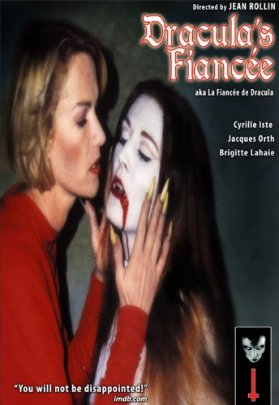

Isabella, Dracula’s fiancée, is quite mad and is kept under the protection of the nuns of the Order of the White Virgin. Fiancee becomes the unbeatable combination of vampires and nuns and the result is some downright Lynchian imagery: Sister Martha does a striptease dance for Mother Superior, a pale female vampire feeds on a nun, Mother Superior lights up her smokes with a crucifix lighter, and a nun has her heart ripped out then walks around with it in her outstretched hands. Again, the motif of the grandfather clock and the beach scene reappear.
No hay comentarios:
Publicar un comentario